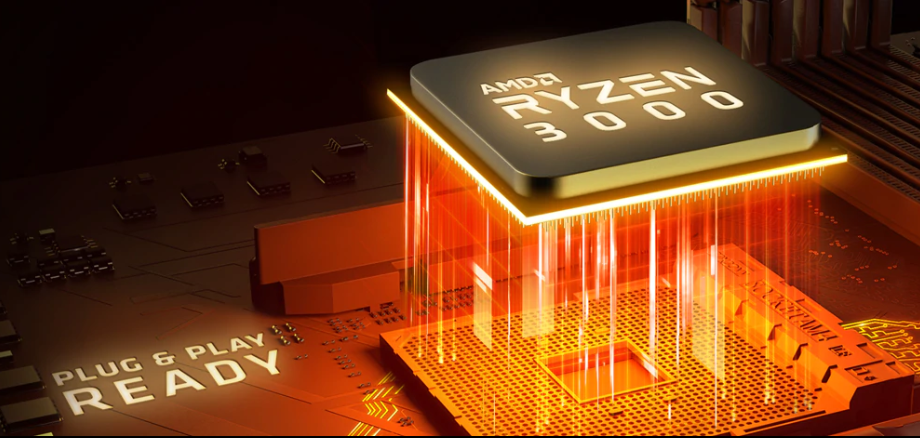 INFRA
INFRA
 INFRA
INFRA
 INFRA
INFRA
Advanced Micro Devices Inc. is taking a few shots at Intel Corp. with the launch late Sunday of its long-awaited 12-core Ryzen 9 3900X microprocessor chip at the Computex event running in Taipei this week.
The chipmaker reckons the new chip easily matches the capabilities of Intel’s best offerings, and even better, it’s available for less than half the price.
AMD’s Ryzen 9 3900X CPU is based on the company’s new seven-nanometer Zen 2 manufacturing process, which means that it squeezes more transistors onto the chip, enabling more calculations than Intel’s latest 12-core chips, which are built on a 14-nanometer process. AMD said it has a boost clock of 4.6 gigahertz with a base clock of 3.8 GHz, packs 70 megabytes of cache storage, and costs just $499, far below the $1,189 price tag for Intel’s rival 12-core i9-9920X.
The “base clock” refers to the absolute minimum frequency the chip runs at, while the “boost clock” is the maximum frequency to which the chip will “boost” when it’s running at a suitable temperature.
But AMD’s new chip doesn’t just beat Intel on price, but performance too, the company said. It claims to beat Intel’s chips by 14% in single-threaded tasks on the Cinebench R20 benchmark test and 6% on multithreaded workloads.
“To be a technology leader, you have to make big bets,” AMD Chief Executive Officer Lisa Su said in a keynote Sunday night.
The Ryzen 9 3900X also boasts a thermal design power rating of 105 watts, compared with the 165 watts TDP of Intel’s Core i9-9920X. In other words, it runs a lot cooler than Intel’s comparable chip.
In addition, AMD unveiled its less powerful eight-core Ryzen 7 3700X, which has a boost clock of 4.4 GHz and a base clock of 3.6 GHz. It also generates just 65 watts of heat. Intel’s i7-9700K eight-core chips put out 95 watts in comparison.
The performance boost is thanks to the superior efficiency of the chip’s central processing unit, which offers a 15% increase in instructions per clock than previous generation chips built on AMD’s Zen 1 architecture. In her keynote, Su said the Ryzen 7 3700X outperforms Intel’s Core i7-9700K by 1% in single-threaded tasks and 28% in multithreaded tasks. It’s also cheaper than Intel’s chip, priced at just $329, compared with $385 for Intel’s.
AMD furthermore offered up a slightly better chip that sits between the Ryzen 9 3900X and the Ryzen 7 3700X, called the Ryzen 7 3800X. In this case, the TDP is bumped up to 105 watts, but the boost clock is pushed to 4.5 GHz, with the base clock rising to 3.9 GHz.
“AMD is trying to become a more relevant player – beyond the traditional desktop,” said Constellation Research Inc. analyst Holger Mueller. “Its push in the miniaturization race with seven-nanometer technology shows technical leadership that the vendor is likely to capitalize on,” especially for data center computers.
“It is possible that AMD is buying its way into these new markets, with very attractive unit pricing,” he added. “Let’s see how the expansion for AMD is going in a few quarters.”
Su was particularly keen to talk about the Ryzen 7 3800X’s gaming performance, noting it offers a 34% higher frame rate in games such as “Counter Strike: Global Offensive.” In other games, such as “Overwatch,” it provides 21% higher frame rates, while in “Dota 2,” it’s 15% faster.
“The new Ryzen desktop price performance per watt looks to be incredible,” said Patrick Moorhead, president and principal analyst at Moor Insights & Strategy. “I’m looking forward to E3 to see more performance numbers and ultimately reviewer benchmarks.”
AMD also announced, but didn’t discuss, two other new Ryzen chips, including a six-core, 12-thread Ryzen 5 3600X and a six-core, 12-thread Ryzen 5 3600.
All five of the new processors will go on sale on July 7, AMD said.
Besides the new chips AMD also revealed its new Navi graphics card, the Radeon RX 5000 series, of which the RX 5700 is the most powerful of the lot. The Navi graphics chips are meant to rival Nvidia Corp.’s GeForce RTX 2070. In a benchmark test, AMD’s Navi not only beat Nvidia’s offering, but did so with a consistent frame per second rate of over 100, according to the company.
The AMD Navi graphics cards are also built on a seven-nanometer process, and will be used in Sony’s next-generation PlayStation 5 console. AMD said the seven-nanometer architecture means the Navi series offers faster clock speeds without boosting power consumption. The graphics cards will go on sale in July.
THANK YOU